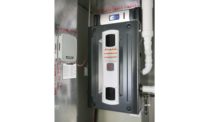HVAC air treatment systems can sometimes be challenging to sell for HVAC contractors, especially with customers that often times unaware about IAQ issues and its potential health effects. With the recent emergence of affordable residential air quality monitors, this game-changing device may very well provide the contractor with successful air treatment systems promotion tools.
Many homeowners aren’t aware of the danger that mold, volatile organic compounds (VOCs), particulates, allergens, and other biological contaminants pose inside their homes. Therefore, they don’t proactively search for a solution.
Contaminants, such as mold, can often times be hidden, out of sight, but still pose odor and potential health related issues that can propagate if not addressed. VOCs have distinct odors and are often problematic in newer construction. The human sense of smell adjusts after long exposure periods and that problematic odor may no longer be a perceived issue, but it still exists. Consequently, these and other airborne contaminants are fairly silent, invisible disrupters of home occupant health and comfort.
Furthermore, IAQ issues are typically unquantifiable and difficult to define.
ON DEMAND IAQ
On demand IAQ is a revolutionary concept when considering that homeowners had no real knowledge of the quality of the air they were breathing within their homes, or even have control over how to address whatever the issues may be. Eliminating VOCs and particulates is just the beginning. Minimizing the potential spread of household infectious diseases, such as influenza and the common cold, should be worth the cost of an air treatment system in itself.
Consider that an estimated 20 million Americans, or one in every 15 suffer from asthma, according to the Asthma and Allergy Foundation of America (AAFA). Based on those statistics, a medium sized HVAC contractor with 1,500 service accounts should have at least 100 asthmatic customers that can truly benefit from an air treatent system.
EMPOWERING THE END-USER: AIR QUALITY MONITOR WITH APP
An air quality monitor empowers the contractor and the homeowner to be proactive in correcting IAQ issues. IAQ can be a tough sell for a contractor because of its subjectivity. However, an air quality monitor can visually quantify and demonstrate how the household IAQ changes throughout the day and by activity, both which impact the air breathed by homeowners.
VOCs, particulates, and CO2 will all trigger the device, notifying the user with a visible warning LED notification of an IAQ event. This is similar to the concept of a thermostat with temperature readouts notifying the homeowner the air handling system is maintaining the desired set point temperature.
Today’s smart air quality monitors take this identifying process a step further with an optional smartphone app. The app will also read out IAQ levels the air quality monitor is sensing. A homeowner with a wireless sensor/monitor “on-demand system” consisting of an air quality monitor and app, can physically and visually evaluate IAQ. If the HVAC system has an air cleaner, the homeowner can manually activate the system’s fan to purify and treat the air in real-time
With today’s airtight home building construction, very little fresh outside air is introduced to dilute and address airborne VOCs and contaminants It is very likely that after a few days of observing the air quality monitor’s notifications, the homeowner might decide to purchase an air treatment system with very little “selling” involved.
AIR CLEANERS
Once the homeowner is ready for an air cleaner, there are multiple brands, methodologies, price points and precautions to investigate. HVAC air cleaning previously consisted of separate particulate filters and some possibly some type of biological disinfection product, such as ultraviolet germicidal irradiation (UVGI) lights, plasma, or eletrostatic devices. Today, biological disinfection air cleaning devices are including emerging VOC solutions, typically consisting of titanium-dioxide carbon media adsorption and photocatalytic oxidation (PCO) technologies.
Air cleaners that can both disinfect biological microorganisms and eliminate VOC issues are the best of both worlds. Biological contaminants can not be sensed by air quality monitors, but they will still be removed from combination UVGI/carbon media air cleaning devices as a result of VOC or particulate sensing from the air quality monitor.
OZONE DANGERS
The precaution when choosing an air cleaner, besides efficacy, is whether or not it emits zero ozone. Ozone has come to the forefont lately due to several organizations detailing its health risks. For example, the U.S. Food and Drug Administration (FDA) was the first to set an ozone emissions limit of 0.05 ppm (50 ppb) for all medical devices. In 2008, the California Air Resources Board (CARB) targeted ozone emissions with a state-wide regulation requiring certification of all electronic air cleaners under UL 867’s 0.05 ppm (50 ppb) limit.
Like the FDA and CARB, the American Society of Heating and Refrigerating Air-Conditioning Engineers (ASHRAE) and the U.S. Environmental Protection Agency (EPA) have both made their ozone viewpoints known in recent publications. ASHRAE’s 2015 publication “Position Document on Filtration and Air Cleaning,” states in Section 2.6 that “Ozone is harmful for health and exposure to ozone creates risk for a variety of symptoms and diseases associated with the respiratory tract; Ozone emission is thus undesirable." Section 3.2 of the document further states: "devices that use the reactivity of ozone for the purpose of cleaning the air should not be used in occupied spaces, because of negative health effects that arise from exposure to ozone and its reaction products.”
Most HVAC applications that utilize UVGI light devices to treat surface-bound or airborne micro-organisms use the germicidal UV-C wavelength of 254-nanometers (nm), which is the most lethal for micro-organisms and is also non-ozone producing. However, some UV-systems may not only utilize UV-C, but also employ a secondary wavelength called UVV (or vacuum UV) at 185-nm, This UVV wavelength produces ozone.
The problems contractors face is determining which brands and products are zero-ozone, Ozone is invisible and difficult to detect, but air cleaning devices generating ozone appear similarly to zero-ozone versions. This ongoing challenge was recently solved when Underwriters Laboratories (UL) recently took on the task of creating a long-awaited validation for zero-ozone air cleaning devices. Consequently, UL 2998 is now an environmental claim procedure with validation that assures contractors of zero-ozone in air cleaners. Therefore, contractors and consumers can now visit UL SPOT (ul.com/spot), a listing all types of sustainable products worldwide. The UL SPOT specifically lists validated zero-ozone products under the site search term of “HVAC Air Cleaners.” Qualifying zero-ozone emission products must demonstrate they emit less than the maximum ozone concentration limit of 0.005 ppm (5 ppb) which is below a quantifiable level for ozone testing. This is 10-fold less than permitted under test standard UL 867, which allows concentrations of 0.05 ppm (50 ppb). Approved products also receive a validation badge that can be displayed on marketing materials and product labels.
FUTURE STEPS
Assuming the homeowner realizing the validity of an air quality monitor and experiences the IAQ improvement that a zero-ozone HVAC-based air cleaner can provide, the final step is a control center that can tie everything together into a complete on-demand IAQ system. The homeowner can use an air quality monitor to determine contaminant levels and manually activate the HVAC system’s fan, or include a smart thermostat that activates the system after receiving a wireless signal from a compatible air quality monitor. The future will bring a HUB, a Cloud-based controlling device that can receive wireless information from the air quality monitor and control an air cleaner HVAC system automatically or manually through a smartphone app. Future HUBs will mount to either HVAC unit or nearby ductwork. The app can display critical real-time performance parameters, such as the current air quality value; mode and status of the HVAC and air treatment system; status of the air cleaner’s UV-C disinfection lamp system; remaining lamp lifecycle; and particulate filter lifespan and replacement schedule. A HUB can also record historical data, spotlights trends and other intuitive functions invaluable for troubleshooting and maintenance issues.
There are additional new construction as well as aftermarket profits that HVAC contractors can make with on-demand IAQ products. An entry level point for consumers is an air quality monitor that can later pave the way for a complete system.
Want more HVAC industry news and information? Join The NEWS on Facebook, Twitter, and LinkedIn today!






Report Abusive Comment